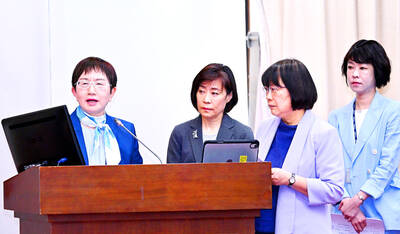The Turkish lira yesterday plunged as much as 12 percent against the yen, forcing Japanese investors to liquidate positions in one of their favorite emerging-market trades for the second time this year.
Much of the lira’s sell-off happened at about 7:20am in Tokyo, when Japanese margin-trading firms typically start closing lossmaking client positions.
Net lira-yen longs held by margin accounts rose last week to the highest level since the middle of June, Tokyo Financial Exchange Inc data showed.
The drop exacerbated after a tit-for-tat exchange of tariffs by China and the US on Friday spurred a rush for haven assets.
Earlier this year, yield-hungry Japanese retail investors were also caught in a flash crash, when the yen in January surged against every currency tracked by Bloomberg during the so-called witching hour of the Asian morning.
“Margin accounts have recently accumulated lira longs,” said Toshiya Yamauchi, chief manager for foreign-exchange margin trading at Ueda Harlow Ltd in Tokyo. “Given the lira’s nature as a high volatility currency, the surge in the yen must have triggered stop-losses this morning.”
The lira plunged to a low of 16.1485 against the yen, before paring most of its slide.
It traded down 1.3 percent at 18.0680 as of 3:18pm in Tokyo.
The early slide was also echoed in other currency pairs, with the lira dropping as much as 9.9 percent against the US dollar.
The Turkish currency was the most actively traded emerging-market currency by Japanese retail investors last month, with ¥1.39 trillion (US$13.2 billion) worth of lira-yen traded that month, according to the latest data from the Financial Futures Association of Japan.
Japanese margin-trading firms tend to evaluate their client positions every day, typically at about 7am in Tokyo and liquidate them if losses reach certain levels.
As Japanese retail investors are typically thirsty for yield, they tend to accumulate long positions in risk assets, leaving them exposed to a sudden rally in the yen, according to a research paper from the Bank of Japan.
The Turkish central bank last month started unwinding last year’s interest-rate hikes, after Turkish President Recep Tayyip Erdogan replaced the bank’s chief for failing to act in line with his expectations for a rate cut.
A run on the lira saw the currency lose about a quarter of its value during August last year, tipping the economy into its first technical recession in a decade.

‘SWASTICAR’: Tesla CEO Elon Musk’s close association with Donald Trump has prompted opponents to brand him a ‘Nazi’ and resulted in a dramatic drop in sales Demonstrators descended on Tesla Inc dealerships across the US, and in Europe and Canada on Saturday to protest company chief Elon Musk, who has amassed extraordinary power as a top adviser to US President Donald Trump. Waving signs with messages such as “Musk is stealing our money” and “Reclaim our country,” the protests largely took place peacefully following fiery episodes of vandalism on Tesla vehicles, dealerships and other facilities in recent weeks that US officials have denounced as terrorism. Hundreds rallied on Saturday outside the Tesla dealership in Manhattan. Some blasted Musk, the world’s richest man, while others demanded the shuttering of his

ADVERSARIES: The new list includes 11 entities in China and one in Taiwan, which is a local branch of Chinese cloud computing firm Inspur Group The US added dozens of entities to a trade blacklist on Tuesday, the US Department of Commerce said, in part to disrupt Beijing’s artificial intelligence (AI) and advanced computing capabilities. The action affects 80 entities from countries including China, the United Arab Emirates and Iran, with the commerce department citing their “activities contrary to US national security and foreign policy.” Those added to the “entity list” are restricted from obtaining US items and technologies without government authorization. “We will not allow adversaries to exploit American technology to bolster their own militaries and threaten American lives,” US Secretary of Commerce Howard Lutnick said. The entities

Minister of Finance Chuang Tsui-yun (莊翠雲) yesterday told lawmakers that she “would not speculate,” but a “response plan” has been prepared in case Taiwan is targeted by US President Donald Trump’s reciprocal tariffs, which are to be announced on Wednesday next week. The Trump administration, including US Secretary of the Treasury Scott Bessent, has said that much of the proposed reciprocal tariffs would focus on the 15 countries that have the highest trade surpluses with the US. Bessent has referred to those countries as the “dirty 15,” but has not named them. Last year, Taiwan’s US$73.9 billion trade surplus with the US

Prices of gasoline and diesel products at domestic gas stations are to fall NT$0.2 and NT$0.1 per liter respectively this week, even though international crude oil prices rose last week, CPC Corp, Taiwan (台灣中油) and Formosa Petrochemical Corp (台塑石化) said yesterday. International crude oil prices continued rising last week, as the US Energy Information Administration reported a larger-than-expected drop in US commercial crude oil inventories, CPC said in a statement. Based on the company’s floating oil price formula, the cost of crude oil rose 2.38 percent last week from a week earlier, it said. News that US President Donald Trump plans a “secondary